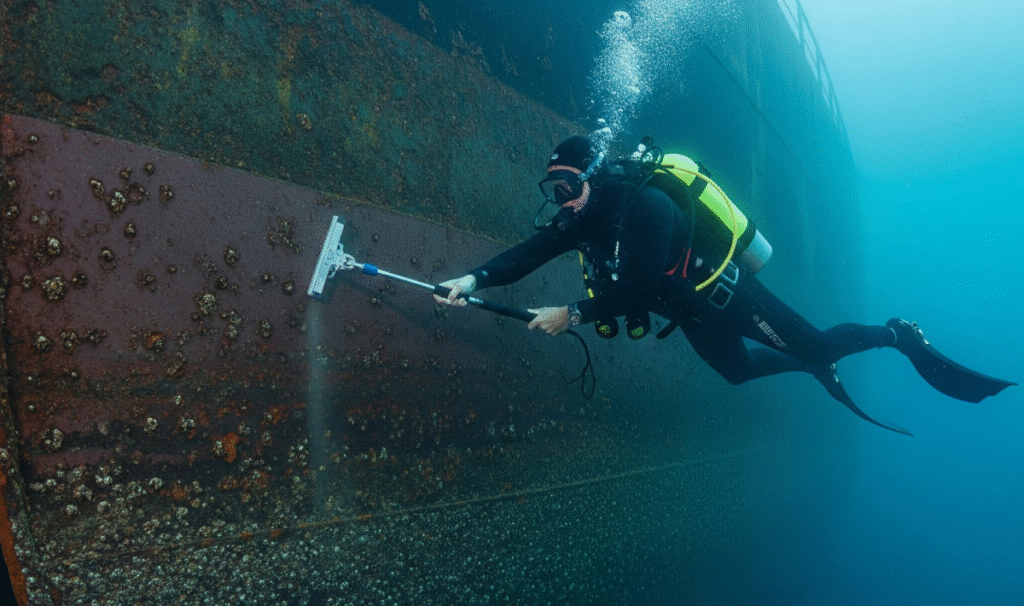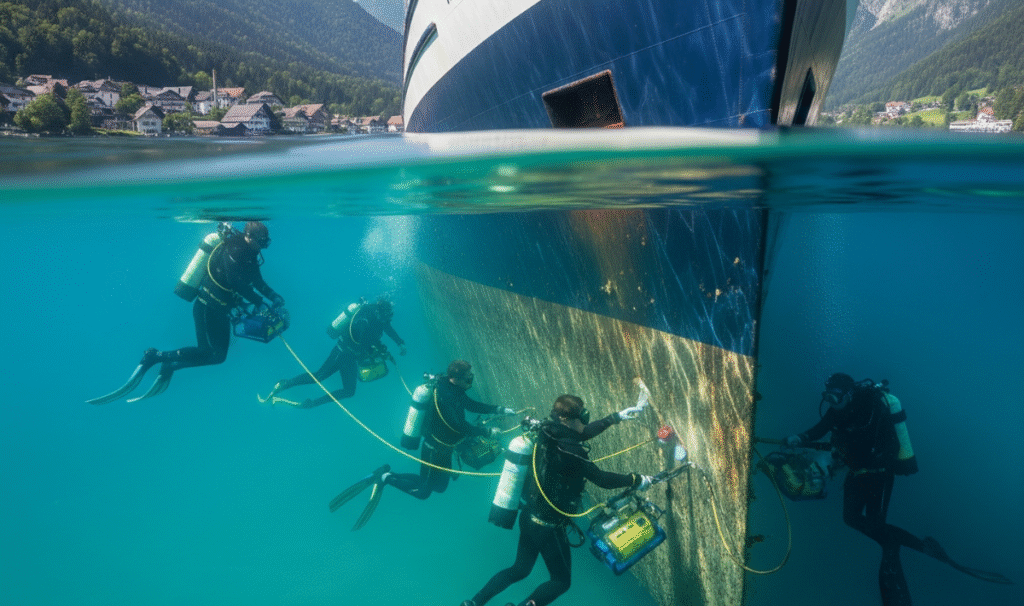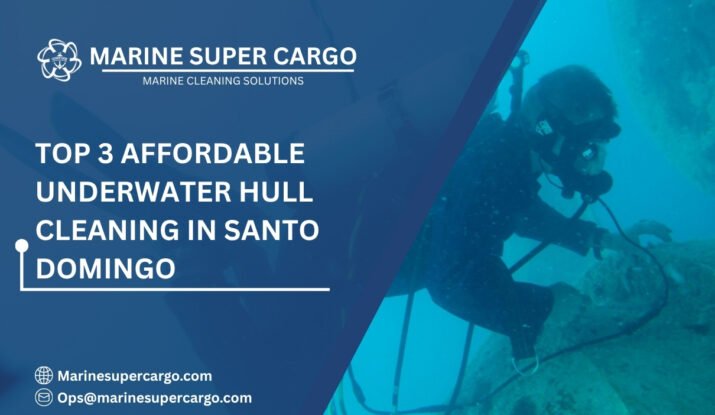If your ship’s hull could talk, it would probably ask for a good cleaning every few months. Why? Just like barnacles cling stubbornly to rocks, marine growth sticks to the underwater hull of vessels, making them slower, less efficient, and more costly to operate. For ship owners and managers, underwater hull cleaning in Santo Domingo has become more than just a maintenance chore—it’s a smart investment for long-term efficiency, compliance, and environmental responsibility.
In this article, let’s explore why hull cleaning matters, why Santo Domingo is such a strategic location for it, and how new technologies are shaping this vital maritime service.
Why Hull Cleaning is Essential
Imagine running a marathon with sandbags tied to your legs. That’s exactly what it feels like for your vessel when biofouling has taken over its hull. Barnacles, moss-like algae, slime layers, and shells create drag, making your engines push harder and burn more fuel.
By choosing underwater hull cleaning in Santo Domingo, ship operators get smoother hulls that reduce energy consumption, lower carbon emissions, and extend the ship’s efficiency curve between dry dockings. A clean hull isn’t just about aesthetics—it’s about fuel savings and better performance.
Santo Domingo: A Strategic Maritime Location
Santo Domingo, the capital of the Dominican Republic, is a central hub for Caribbean maritime traffic. Its port serves as both a commercial and logistical stop for global shipping routes.
Getting underwater hull cleaning in Santo Domingo makes sense because:
- Ships often dock for loading, unloading, or refueling.
- Cleaning services can be performed without major schedule disruptions.
- The region’s tropical waters mean biofouling develops quickly, making timely cleaning critical.
For many ship owners, Santo Domingo is not just a stopover—it’s an opportunity to optimize performance mid-voyage.

The Science of Biofouling
Underwater growth doesn’t happen overnight; it creeps in subtly with every voyage. However, once established, it compounds rapidly, turning a smooth hull into a rough, drag-inducing surface.
- Slime film: A slippery microbial layer that forms the foundation for larger organisms.
- Barnacles: Hard, crusty colonies that significantly increase drag.
- Algae and mussels: Add layers of resistance and roughness.
- Corrosion accelerators: Fouling can trap moisture, causing coatings to wear.
Regular underwater hull cleaning in Santo Domingo interrupts this cycle, reducing surface roughness and preventing long-term structural damage.
Compliance with International Standards
Hull cleaning is not just about saving money—it’s also about meeting international environmental and safety obligations. Organizations like the International Maritime Organization (IMO) and standards under MARPOL emphasize controlling emissions and avoiding the transfer of invasive species.
Here’s how underwater hull cleaning in Santo Domingo ties in with compliance:
- IMO Biofouling Guidelines: Recommend proactive cleaning to minimize biological invasions.
- MARPOL Annex VI: Targets fuel efficiency and reduces air pollution.
- IMCA Standards: Regulate diver safety during underwater operations.
By following these standards, vessel operators avoid penalties and align with global shipping initiatives for greener operations.
Environmental Impact of Hull Cleaning
The Caribbean’s biodiversity requires careful management during maintenance operations. A fouled hull can carry invasive organisms from one marine ecosystem to another, potentially disrupting local habitats.
Eco-conscious underwater hull cleaning in Santo Domingo helps reduce this risk. Responsible cleaning practices, using debris-capture and filtration systems, ensure biofouling waste doesn’t simply float away into the waters. The environmental benefits include:
- Reduced transfer of harmful species
- Lower carbon footprint from optimized fuel use
- Better preservation of port ecosystems
- Longer-lasting hull coatings, meaning fewer toxic reapplications
Cost Savings That Stack Up
Fuel spikes are the bane of every ship owner’s budget. With fouled hulls increasing drag, engines must work harder, leading to fuel consumption hikes of up to 40%.
By investing in underwater hull cleaning in Santo Domingo, ship managers benefit from:
- Up to 10–15% savings on fuel bills
- Fewer unscheduled dry-docking repairs
- Longer coating lifespans, lowering maintenance expenses
- Compliance savings by avoiding emissions-related penalties
Hull cleaning is one of those rare maritime investments that pays for itself quickly, voyage after voyage.
How Hull Cleaning is Performed
The actual cleaning process combines diver expertise and advanced equipment. A typical underwater hull cleaning in Santo Domingo involves:
- Pre-inspection: Divers or remotely operated vehicles (ROVs) check the hull with video feeds.
- Mechanical brushing: Specialized brushes carefully remove slime, barnacles, and mussels.
- Propeller polishing: Ensures better propulsion efficiency and reduced cavitation.
- Detailed reporting: Owners receive video or photographic proof for records and audits.
Using modern equipment ensures fouling is removed without damaging antifouling coatings, maximizing the hull’s protective lifespan.
Safety Considerations
Hull cleaning involves divers working in challenging environments, so safety is a core priority. According to IMCA guidelines, operators in Santo Domingo follow strict protocols to protect divers and equipment.
These measures include:
- Pre-dive medical checks and training verification
- Surface-supplied air and communication systems
- Emergency backup procedures
- Adherence to decompression and oxygen protocols
Thanks to such measures, underwater hull cleaning in Santo Domingo is a safe, standardized, and efficient service.
Innovations Reshaping the Industry
The future of hull cleaning lies in robotics, artificial intelligence, and eco-conscious engineering. While divers remain essential, new technologies are quickly changing the game.
Some key innovations for underwater hull cleaning in Santo Domingo include:
- Robotic cleaners: Autonomous machines fitted with rotating brushes and suction systems.
- Waste-capture systems: Collect dislodged organisms to prevent contamination.
- Data-driven performance tracking: Using sensors to analyze drag increase over time.
- Smart antifouling coatings: Reducing how fast biofouling builds up.
The push towards digitization and sustainability ensures ship owners gain efficiency without compromising ecosystems.

Why Santo Domingo is the Right Choice
With high shipping activity, tropical conditions, and growing maritime services, Santo Domingo sits at the crossroads of efficiency and opportunity. Ship owners benefit by planning underwater hull cleaning in Santo Domingo because it combines strategic positioning with professional facilities and eco-conscious service providers.
When time is money, this Caribbean port offers the perfect balance between operational convenience and sustainable solutions.
Conclusion
At sea, a dirty hull is the silent thief of profits, fuel, and efficiency. Opting for underwater hull cleaning in Santo Domingo ensures ships run smoother, consume less fuel, and stay compliant with tough international regulations. Beyond the economic gains, it also protects the environment by minimizing biofouling’s ecological footprint.
For ship owners, operators, and managers, hull cleaning in Santo Domingo isn’t just maintenance—it’s a forward-thinking strategy for safer, smarter, and greener global shipping.
Similar market advantages are discussed in underwater hull cleaning in the UK.
FAQ:
Q1. Why is underwater hull cleaning in Santo Domingo critical for vessels in tropical waters?
Because warm Caribbean waters accelerate biofouling growth, ships sailing here require more frequent cleaning to stay efficient.
Q2. How much can I save with regular hull cleaning?
Depending on the extent of fouling, ships can save up to 15% on fuel costs, which quickly covers the cost of cleaning services.
Q3. Can underwater cleaning damage the hull’s coating?
Not if performed by professionals. High-quality brushes clean fouling without stripping protective coatings.
Q4. Is underwater hull cleaning eco-friendly in Santo Domingo?
Yes. Many services use collection systems and follow environmental guidelines to reduce marine impact.
Q5. Will robotic systems replace divers completely?
Not entirely. Robots are increasingly used, but skilled divers remain crucial for complex cleaning and inspection tasks.


